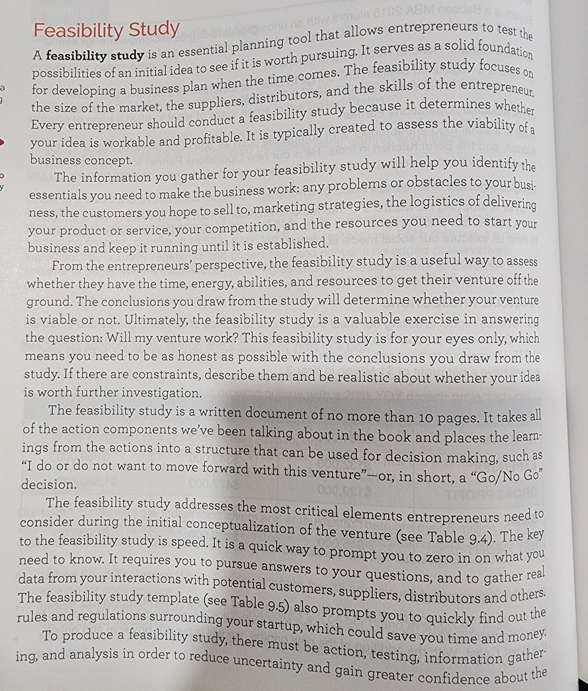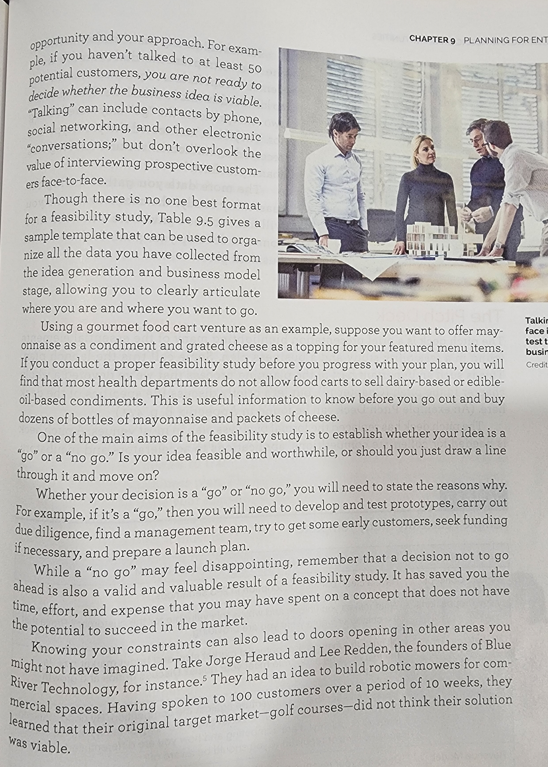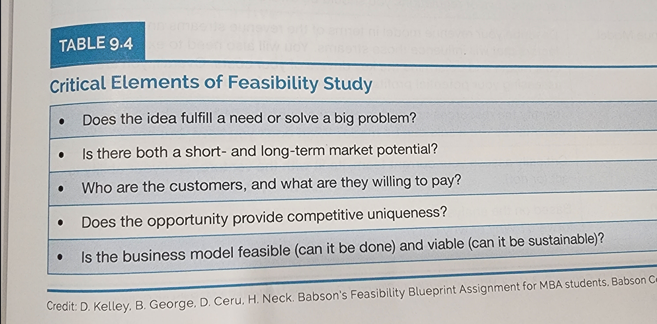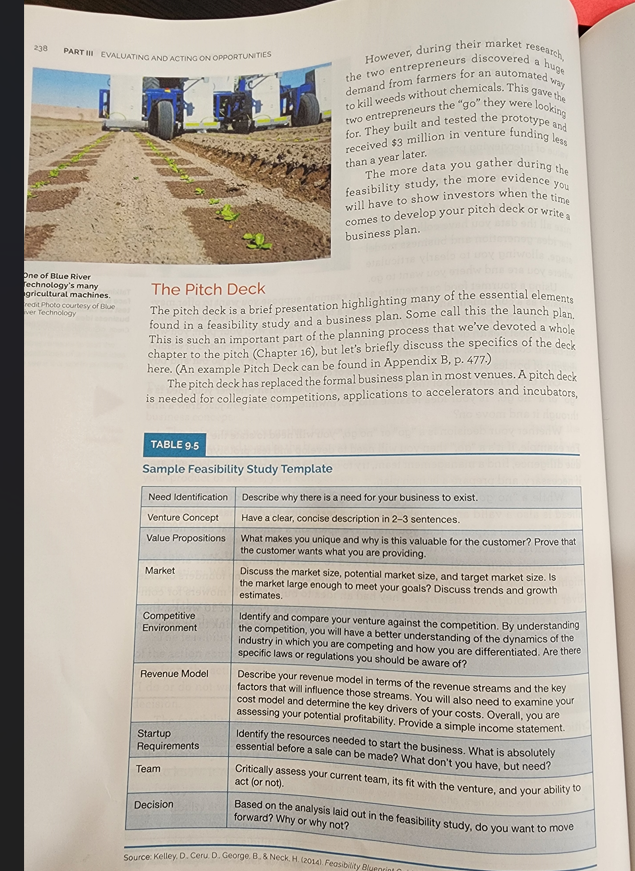Question
Chapter 9 covers the critical elements necessary to create a feasibility study on page 237 in Table 9.4. In this written document (3-5 pages), address
Chapter 9 covers the critical elements necessary to create a feasibility study on page 237 in Table 9.4. In this written document (3-5 pages), address each of the critical elements in your study. There is no set template for your team's document, so choose one that best fits your business proposition. Remember to keep your Food truck business venture investment at $1M or less. At the conclusion of your study, make a determination based on your team's analysis if it is a good idea to move forward with the food truck business venture. Explain why it is a good idea, or if adjustments need to be made. I expect to see at least 6+ credible sources.



Address each of the critical feasibility study question in Table 9.4 to discuss the Food Truck Business Venture and whether or not it is a good idea to move forward with this proposition.
A feasibility study is an essential planning tool that allows entrepreneurs to test the Feasibility Study possibilities of an initial idea to see if it is worth pursuing. It serves as a solid foundation for developing a business plan when the time comes. The feasibility study focuses on the size of the market, the suppliers, distributors, and the skills of the entrepreneur. Every entrepreneur should conduct a feasibility study because it determines whether your idea is workable and profitable. It is typically created to assess the viability of a The information you gather for your feasibility study will help you identify the business concept. essentials you need to make the business work: any problems or obstacles to your business, the customers you hope to sell to, marketing strategies, the logistics of delivering your product or service, your competition, and the resources you need to start your business and keep it running until it is established. From the entrepreneur' perspective, the feasibility study is a useful way to assess whether they have the time, energy, abilities, and resources to get their venture off the ground. The conclusions you draw from the study will determine whether your venture is viable or not. Ultimately, the feasibility study is a valuable exercise in answering the question: Will my venture work? This feasibility study is for your eyes only, which means you need to be as honest as possible with the conclusions you draw from the study. If there are constraints, describe them and be realistic about whether your idea is worth further investigation. The feasibility study is a written document of no more than 10 pages. It takes all of the action components we've been talking about in the book and places the learnings from the actions into a structure that can be used for decision making, such as "I do or do not want to move forward with this venture"-or, in short, a "Go/No Go" decision. The feasibility study addresses the most critical elements entrepreneurs need to consider during the initial conceptualization of the venture (see Table 9.4). The key to the feasibility study is speed. It is a quick way to prompt you to zero in on what you need to know. It requires you to pursue answers to your questions, and to gather real data from your interactions with potential customers, suppliers, distributors and others. The feasibility study template (see Table 9.5) also prompts you to quickly find out the rules and regulations surrounding your startup, which could save you time and money. To produce a feasibility study, there must be action, testing, information gathering, and analysis in order to reduce uncertainty and gain greater confidence about the opportunity and your approach. For example, if you haven't talked to at least 50 potential customers, you are not ready to decide whether the business idea is viable. "Talking" can include contacts by phone, social networking, and other electronic "conversations;" but don't overlook the value of interviewing prospective customers face-to-face. Though there is no one best format for a feasibility study, Table 9.5 gives a sample template that can be used to organize all the data you have collected from the idea generation and business model stage, allowing you to clearly articulate where you are and where you want to go. Using a gourmet food cart venture as an example, suppose you want to offer mayonnaise as a condiment and grated cheese as a topping for your featured menu items. If you conduct a proper feasibility study before you progress with your plan, you will find that most health departments do not allow food carts to sell dairy-based or edibleoil-based condiments. This is useful information to know before you go out and buy dozens of bottles of mayonnaise and packets of cheese. One of the main aims of the feasibility study is to establish whether your idea is a "go" or a "no go." Is your idea feasible and worthwhile, or should you just draw a line through it and move on? Whether your decision is a "go" or "no go," you will need to state the reasons why. For example, if it's a "go," then you will need to develop and test prototypes, carry out due diligence, find a management team, try to get some early customers, seek funding if necessary, and prepare a launch plan. While a "no go" may feel disappointing, remember that a decision not to go ahead is also a valid and valuable result of a feasibility study. It has saved you the time, effort, and expense that you may have spent on a concept that does not have the potential to succeed in the market. Knowing your constraints can also lead to doors opening in other areas you might not have imagined. Take Jorge Heraud and Lee Redden, the founders of Blue River Technology, for instance. 5 They had an idea to build robotic mowers for commercial spaces. Having spoken to 100 customers over a period of 10 weeks, they learned that their original target market-golf courses-did not think their solution was viable. Critical Elements of Feasibility Study - Does the idea fulfill a need or solve a big problem? - Is there both a short- and long-term market potential? - Who are the customers, and what are they willing to pay? - Does the opportunity provide competitive uniqueness? - Is the business model feasible (can it be done) and viable (can it be sustainable)? Credit: D. Kelley. B. George. D. Ceru. H. Neck. Babson's Feasibility Blueprint Assignment for MBA students. Babson 238 PART III EVALUATING AND ACTING ON OPPORTUNITIES However, during their market research, the two entrepreneurs discovered a hugg, demand from farmers for an automated way to kill weeds without chemicals. This gave the two entrepreneurs the "go" they were looking for. They built and tested the prototype and received $3 million in venture funding less than a year later. The more data you gather during the feasibility study, the more evidence you will have to show investors when the time comes to develop your pitch deck or write a business plan. Dne of Btue River fechnology's many pedit phow courtesy of Buwe ver Technology The pitch deck is a brief presentation highlighting many of the essential elements griculturat machines. found in a feasibility study and a business plan. Some call this the launch plan. This is such an important part of the planning process that we've devoted a whole chapter to the pitch (Chapter 16 ), but let's briefly discuss the specifics of the deck here. (An example Pitch Deck can be found in Appendix B, p. 477.) The pitch deck has replaced the formal business plan in most venues. A pitch deck is needed for collegiate competitions, applications to accelerators and incubatorsStep by Step Solution
There are 3 Steps involved in it
Step: 1

Get Instant Access to Expert-Tailored Solutions
See step-by-step solutions with expert insights and AI powered tools for academic success
Step: 2

Step: 3

Ace Your Homework with AI
Get the answers you need in no time with our AI-driven, step-by-step assistance
Get Started


